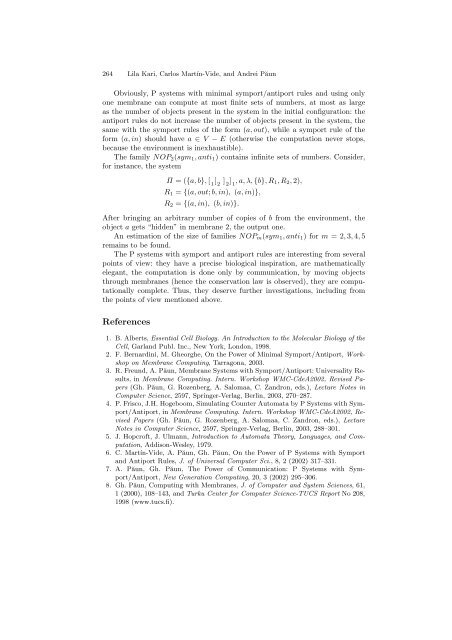LNCS 2950 - Aspects of Molecular Computing (Frontmatter Pages)
LNCS 2950 - Aspects of Molecular Computing (Frontmatter Pages)
LNCS 2950 - Aspects of Molecular Computing (Frontmatter Pages)
Create successful ePaper yourself
Turn your PDF publications into a flip-book with our unique Google optimized e-Paper software.
264 Lila Kari, Carlos Martín-Vide, and Andrei Păun<br />
Obviously, P systems with minimal symport/antiport rules and using only<br />
one membrane can compute at most finite sets <strong>of</strong> numbers, at most as large<br />
as the number <strong>of</strong> objects present in the system in the initial configuration: the<br />
antiport rules do not increase the number <strong>of</strong> objects present in the system, the<br />
same with the symport rules <strong>of</strong> the form (a, out), while a symport rule <strong>of</strong> the<br />
form (a, in) should have a ∈ V − E (otherwise the computation never stops,<br />
because the environment is inexhaustible).<br />
The family NOP2(sym1,anti1) contains infinite sets <strong>of</strong> numbers. Consider,<br />
for instance, the system<br />
Π =({a, b}, [ 1 [ 2 ] 2 ] 1 ,a,λ,{b},R1,R2, 2),<br />
R1 = {(a, out; b, in), (a, in)},<br />
R2 = {(a, in), (b, in)}.<br />
After bringing an arbitrary number <strong>of</strong> copies <strong>of</strong> b from the environment, the<br />
object a gets “hidden” in membrane 2, the output one.<br />
An estimation <strong>of</strong> the size <strong>of</strong> families NOPm(sym1,anti1) form =2, 3, 4, 5<br />
remains to be found.<br />
The P systems with symport and antiport rules are interesting from several<br />
points <strong>of</strong> view: they have a precise biological inspiration, are mathematically<br />
elegant, the computation is done only by communication, by moving objects<br />
through membranes (hence the conservation law is observed), they are computationally<br />
complete. Thus, they deserve further investigations, including from<br />
the points <strong>of</strong> view mentioned above.<br />
References<br />
1. B. Alberts, Essential Cell Biology. An Introduction to the <strong>Molecular</strong> Biology <strong>of</strong> the<br />
Cell, Garland Publ. Inc., New York, London, 1998.<br />
2. F. Bernardini, M. Gheorghe, On the Power <strong>of</strong> Minimal Symport/Antiport, Workshop<br />
on Membrane <strong>Computing</strong>, Tarragona, 2003.<br />
3. R. Freund, A. Păun, Membrane Systems with Symport/Antiport: Universality Results,<br />
in Membrane <strong>Computing</strong>. Intern. Workshop WMC-CdeA2002, Revised Papers<br />
(Gh. Păun, G. Rozenberg, A. Salomaa, C. Zandron, eds.), Lecture Notes in<br />
Computer Science, 2597, Springer-Verlag, Berlin, 2003, 270–287.<br />
4. P. Frisco, J.H. Hogeboom, Simulating Counter Automata by P Systems with Symport/Antiport,<br />
in Membrane <strong>Computing</strong>. Intern. Workshop WMC-CdeA2002, Revised<br />
Papers (Gh. Păun, G. Rozenberg, A. Salomaa, C. Zandron, eds.), Lecture<br />
Notes in Computer Science, 2597, Springer-Verlag, Berlin, 2003, 288–301.<br />
5. J.Hopcr<strong>of</strong>t,J.Ulmann,Introduction to Automata Theory, Languages, and Computation,<br />
Addison-Wesley, 1979.<br />
6. C. Martín-Vide, A. Păun, Gh. Păun, On the Power <strong>of</strong> P Systems with Symport<br />
and Antiport Rules, J. <strong>of</strong> Universal Computer Sci., 8, 2 (2002) 317–331.<br />
7. A. Păun, Gh. Păun, The Power <strong>of</strong> Communication: P Systems with Symport/Antiport,<br />
New Generation <strong>Computing</strong>, 20, 3 (2002) 295–306.<br />
8. Gh. Păun, <strong>Computing</strong> with Membranes, J. <strong>of</strong> Computer and System Sciences, 61,<br />
1 (2000), 108–143, and Turku Center for Computer Science-TUCS Report No 208,<br />
1998 (www.tucs.fi).
















